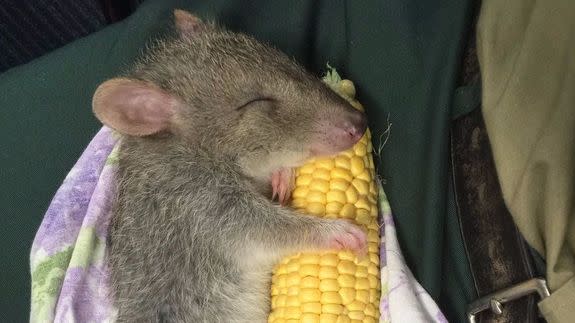The eastern bettong is an adorable Aussie animal that just wants your love

Australia has plenty of cute animals that get attention. Koalas, kangaroos and quokkas are talked about all the time, but there's a new creature that deserves the limelight.
That would be the little-known eastern bettong, a short-nosed marsupial, which until only recently had been extinct on the Australian mainland.
SEE ALSO: Hang out with these rather charming dingo puppies
Once ubiquitous around the northern fringes of the city of Canberra, they were eradicated in the early-20th century thanks to introduced predators such as foxes and cats, as well as humans who saw them as a threat to agriculture. Luckily, there was still a population of eastern bettongs in the state of Tasmania.
Since 2012, small batches of the species have been reintroduced into Mulligan's Flat, a sanctuary near Canberra, which is helping bring back the eastern bettong and other species.
Kate Grarock, an ecologist at the sanctuary, is one of the people helping these animals return to their habitat. She wants to make sure the eastern bettong is an animal people remember.
"No-one's heard of a bettong, except for people who've been to Tasmania, or lived in Tasmania," Grarock told Mashable Australia. "I studied environmental science, and I hadn't even heard of one. It's a representation of the sad state of affairs for these little bettongs. They're really cool little animals."
Grarock has two hand-raised eastern bettongs, Brian and Berry, which she takes to schools to teach children about native animals. Like many of the Australian animals clinging onto survival, awareness is key to ensuring protection.
"A lot of them aren't doing terribly well, which is why I guess kids aren't learning about them," Grarock said. "At Mulligan's [Flat], we feel like people need to be aware of them and grow to love them to ensure they're protected."
You can follow Brian and Berry's movements on their Twitter, Facebook or Vine accounts.
"What we're trying to do is get the message out there and make people fall in love with these gorgeous little animals. But of course, they're more than cool little animals, they're doing great things for the ecosystem too," Grarock said.
There are more than 300 eastern bettongs in the sanctuary now, helping to improve the environmental health of the area. They do this by digging up native truffles at night and spreading them.
"The really cool thing that truffles do is that they have a symbiotic relationship with tree roots," she explained. Truffles help extend tree roots so they can absorb more nutrients, ultimately leading to stronger and healthier trees.
Ultimately, the goal is to help the eastern bettong flourish again in Canberra, which would require an improved fence to be built around the Mulligan's Flat sanctuary.
While the government has assisted with some funding, the sanctuary needs A$600,000 (US$451,000) from the public to make it happen. It's time to make these eastern bettongs world-famous. After all, who could resist this face?
